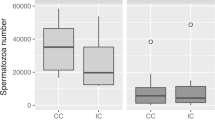Abstract
We compared sex differences in behaviors leading to copulation of chimpanzees (Pan troglodytes) in the Kalinzu Forest, Uganda with those of bonobos (Pan paniscus) at Wamba, D.R. Congo, using the same definition. Female chimpanzees were more likely to initiate copulation than female bonobos. While most of copulations (96%) were initiated by males in bonobos, among chimpanzees only 63% of copulations were initiated by males. Female bonobos initiated an interaction leading to copulation when males approached them within a short distance. On the other hand, both male and female chimpanzees initiated behavior at a longer distance. Higher proceptivity and a higher copulation rate during the maximal swelling period of female chimpanzees might suggest that they gain greater benefits from a high frequency of copulations than do female bonobos.


Similar content being viewed by others
References
Boesch C, Boesch-Achermann H (2000) The chimpanzees of the Tai Forest: behavioural ecology and evolution. Oxford University Press, Oxford
Dixson AF (1998) Primate sexuality: comparative studies of the prosimians, monkeys, apes, and human beings. Oxford University Press, Oxford
Furuichi T (1987) Sexual swelling, receptivity and grouping of wild pygmy chimpanzee females at Wamba, Zaïre. Primates 28:309–318
Furuichi T (1992) The prolonged estrus of females and factors influencing mating in a wild group of bonobos (Pan paniscus) in Wamba, Zaïre. In: Itoigawa N, Sugiyama Y, Sackett GP, Thompson RKR (eds) Topics in primatology, vol 2. Behavior, ecology, and conservation. University of Tokyo Press, Tokyo, pp 179–190
Furuichi T, Hashimoto C (2002) Why female bonobos have a lower copulation rate during estrus than chimpanzees. In: Boesch C, Hohmann G, Marchant L (eds) Behavioral diversity of chimpanzees and bonobos. Cambridge University Press, Cambridge, pp 156–167
Furuichi T, Hashimoto C (2004) Sex differences in copulation attempts in wild bonobos at Wamba. Primates 45:59–62
Goodall J (1986) The chimpanzees of Gombe. Harvard University Press/Belknap, Cambridge, Mass.
Hashimoto C (1995) Population census of the chimpanzees in the Kalinzu Forest, Uganda: comparison between methods with nest counts. Primates 36:477–488
Hashimoto C (1997) Context and development of sexual behavior of wild bonobos (Pan paniscus) at Wamba, Zaïre. Int J Primatol 18:1–21
Hashimoto C, Furuichi T (2003) Extremely high frequency of promiscuous mating of female chimpanzees observed in the Kalinzu Forest, Uganda. Primate Res 19:17–22 (in Japanese with English abstract)
Hashimoto C, Tashiro Y, Kimura D, Enomoto T, Ingmanson EJ, Idani G, Furuichi T (1998) Habitat use and ranging of wild bonobos (Pan paniscus) at Wamba. Int J Primatol 19:1045–1060
Hashimoto C, Furuichi T, Tashiro Y, Kimura D (1999) Vegetation of the Kalinzu Forest, Uganda: ordination of forest types using principal component analysis. Afr Stud Monogr 20:229–239
Hashimoto C, Furuichi T, Tashiro Y (2001) What factors affect the size of chimpanzee parties in the Kalinzu Forest, Uganda? Examination of fruit abundance and number of estrous females. Int J Primatol 22:947–959
Howard PC (1991) Nature conservation in Uganda’s tropical forest reserves. IUCN, Gland, Switzerland
Hrdy SB (1977) The Langur of Abu. Harvard University Press, Cambridge
Hrdy SB (1981) The woman that never evolved. Harvard University Press, Cambridge
Kano T (1989) The sexual behavior of pygmy chimpanzees. In: Heltne PG, Marquardt L (eds) Understanding chimpanzees. Harvard University Press, Cambridge, Mass., pp 176–183
Kano T (1992) The last ape: pygmy chimpanzee behavior and ecology. Stanford University Press, Stanford, Calif.
Nishida T (1980) The leaf-clipping display: a newly-discovered expressive gesture in wild chimpanzees. J Hum Evol 9:117–128
Nishida T (1997) Sexual behavior of adult male chimpanzees of the Malahe Mountains National Park, Tanzania. Primates 38:379–398
van Schaik CP (2000) Social counterstrategies against infanticide by males in primates and other mammals. In: Kappeler PM (eds) Primate males: causes and consequences of variation in group composition. Cambridge University Press, Cambridge, pp 34–54
Short RV (1979) Sexual selection and its component parts, somatic and genital selection, as illustrated by man and the great apes. Adv Stud Behav 9:131–158
Takahata Y, Ihobe H, Idani G (1996) Comparing copulations of chimpanzees and bonobos: do females exhibit proceptivity or receptivity? In: McGrew EW, Marchant LF, Nishida T (eds) Great ape societies. Cambridge University Press, Cambridge, pp 146–155
Whitten PL (1987) Infants and adult males. In: Smuts BB, Cheney DL, Seyfarth RM, Wrangham RW, Struhsaker TT (eds) Primate society. University of Chicago Press, Chicago, pp 343–357
Wrangham RW (1993) The evolution of sexuality in chimpanzees and bonobos. Hum Nat 4:47–79
Wrangham RW (2002) The cost of sexual attraction: Is there a trade-off in female Pan between sex appeal and received coercion?. In: Boesch C, Hohmann G, Marchant L (eds) Behavioral diversity of chimpanzees and bonobos. Cambridge University Press, Cambridge, pp 204–215
Wright PC (1990) Patterns of paternal care in primates. Int J Primatol 11:89–102
Acknowledgements
We much appreciate having an opportunity to talk at the international symposium “African Great Apes Evolution, Diversity, and Conservation”. We thank T. Kano, T. Nishida, O. Takenaka, and Mwanza-Ndunda who provided opportunities for field study and data analyses; the Uganda National Council for Science and Technology, the Uganda Forestry Department, and the Uganda Wildlife Authority for giving us research permission in Kalinzu; and Nkoy-Batolumbo and other staffs at Wamba and Kalinzu who aided our field observations. This study was financially supported by Monbusho International Scientific Research Program grants to T. Kano (63041078), T. Nishida (12375003), and T. Furuichi (01790353, 12575017), and by a grant from the Monbusho COE Program to O. Takenaka (10CE2005).
Author information
Authors and Affiliations
Corresponding author
About this article
Cite this article
Hashimoto, C., Furuichi, T. Comparison of behavioral sequence of copulation between chimpanzees and bonobos. Primates 47, 51–55 (2006). https://doi.org/10.1007/s10329-005-0144-x
Received:
Accepted:
Published:
Issue Date:
DOI: https://doi.org/10.1007/s10329-005-0144-x




